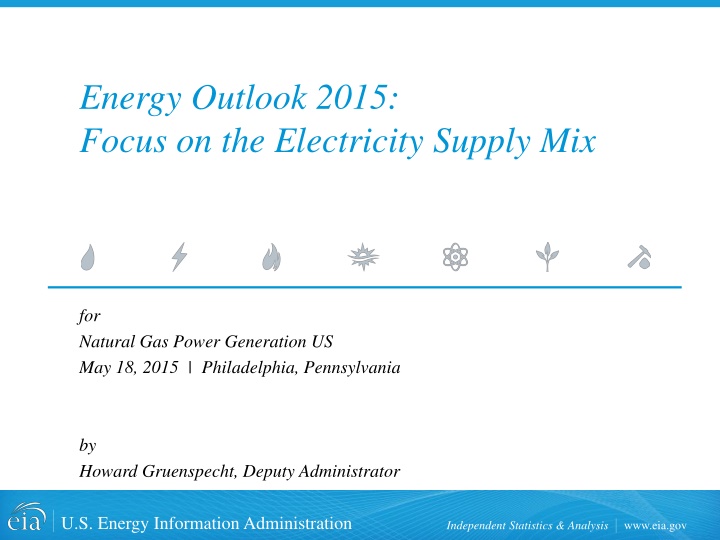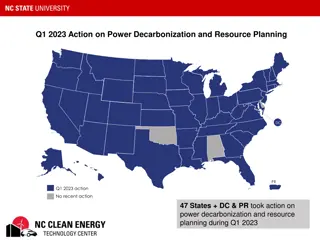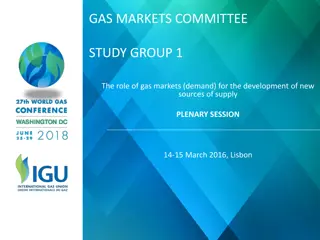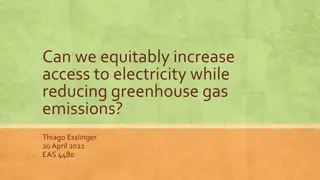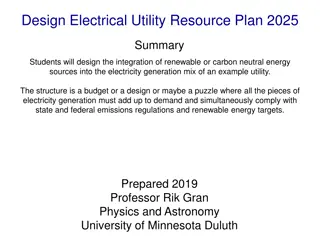Focus on the Electricity Supply Mix for Natural Gas Power Generation in the US
This Energy Outlook 2015 report delves into the dynamics of the electricity supply mix for natural gas power generation in the United States. It discusses the trends in coal, natural gas, renewables, and other energy sources, highlighting coal plant retirements and the impact on natural gas usage. The report also covers the forecasts and projections for electricity generation from different sources, emphasizing the role of natural gas, renewables, and coal in the overall energy landscape.
Download Presentation

Please find below an Image/Link to download the presentation.
The content on the website is provided AS IS for your information and personal use only. It may not be sold, licensed, or shared on other websites without obtaining consent from the author.If you encounter any issues during the download, it is possible that the publisher has removed the file from their server.
You are allowed to download the files provided on this website for personal or commercial use, subject to the condition that they are used lawfully. All files are the property of their respective owners.
The content on the website is provided AS IS for your information and personal use only. It may not be sold, licensed, or shared on other websites without obtaining consent from the author.
E N D
Presentation Transcript
Energy Outlook 2015: Focus on the Electricity Supply Mix for Natural Gas Power Generation US May 18, 2015 | Philadelphia, Pennsylvania by Howard Gruenspecht, Deputy Administrator U.S. Energy Information Administration www.eia.gov Independent Statistics & Analysis
U.S. Energy Information Administration Statistical and analytical agency within the U.S. Department of Energy Produces monthly short-term and annual long-term projections Produces special analyses of emerging issues and regulatory changes EIA s analyses and projections are independent, by law, and should not be seen as representing the views of the Department of Energy, the Administration, or any other organization. Energy Outlook 2015 May 18, 2015 2
Short-term Energy Outlook 2015 May 18, 2015 3
U.S. Monthly Net Electric Power Generation, 2010 - 2016 U.S. electricity generation by energy source gigawatthours per day 6 forecast 5 4 3 2 1 0 Jan-10 Jan-11 Natural gas Jan-12 Nuclear Jan-13 Hydroelectric Jan-14 Jan-15 Jan-16 Other sources Coal Other renewables Source: EIA, Short-Term Energy Outlook, April 2015 Energy Outlook 2015 May 18, 2015 4
In EIAs forecast, coals share of summer generation falls to historic low while natural gas and renewables match or exceed record highs average daily power generation, by fuel source, April through October billion kilowatt hours per day 12 120% 14% 14% 14% 13% 15% 100% 9 18% 19% 18% 19% 18% 80% Renewables/other 26% 32% 29% 32% 6 29% 60% Nuclear 40% Natural gas 42% 38% 37% 37% 3 35% 20% Coal 0 0% 2011 2012 2013 2014 2015 (forecast) Source: Electric Power Monthly, EIA Short-Term Energy Outlook April 2015 Energy Outlook 2015 May 18, 2015 5
Coal plant retirements have had minimal impact on gas use for generation to date Recent and near-term coal retirements have operated at below-average capacity factors Average capacity factor for coal plants is 58% Low natural gas prices have been the main driver of coal displacement Capacity Factor Based on 2013 April October Generation Coal Retirements by Year, Net Summer Capacity (MW) 2013 April October Generation (thousand MWh) Equivalent Natural Gas Consumption (Bcf/d) 2014 2,758 11% 1,615 0.1 2015 13,939 25% 18,086 0.7 2016 4,587 46% 10,724 0.4 Note: Estimates for 2015 and 2016 subject to change based on EIA-860 survey responses Source: EIA, Annual Energy Outlook 2015; Electric Power Annual 2013 Energy Outlook 2015 May 18, 2015 6
EIA forecast for Henry Hub prices is slightly above the Nymex strip through 2016; however, confidence intervals based on options values suggest a wide band of uncertainty in price projections Henry Hub spot price dollars per million Btu 7 6 5 4 3 Historical Spot Price 2 STEO Forecast NYMEX Futures Price 1 95% NYMEX futures price confidence interval 0 Jan Apr Jul 2013 Oct Jan Apr Jul 2014 Oct Jan Apr Jul Oct Jan Apr Jul Oct 2015 2016 Source: EIA, Short-Term Energy Outlook, May 2015 Effects of low oil prices May 12, 2015 7
Industrial and power sectors drive natural gas consumption growth in the forecast Natural gas consumption billion cubic feet per day annual change billion cubic feet per day 120 8 110 7 100 6 90 5 80 4 70 3 60 2 50 1 40 0 30 -1 20 -2 10 0 -3 2013 Electric power (right axis) Industrial (right axis) Total consumption (left axis) 2014 2015 Residential and comm. (right axis) Other (right axis) Consumption forecast (left axis) 2016 Source: EIA, Short-Term Energy Outlook, May 2015 Effects of low oil prices May 12, 2015 8
Long-term Energy Outlook 2015 May 18, 2015 9
AEO2015 underpinnings Reference case: assumes current laws and regulations - Reinstatement of the Clean Air Interstate Rule (CAIR) after the court's announcement of intent to vacate the Cross-State Air Pollution Rule (CSAPR) - Includes representation of Mercury and Air Toxics Standards (MATS), with effective implementation date assumed to be 2016 rather than 2015 - Includes state renewable portfolio standards - Represents California s cap-and-trade program and the Northeast s RGGI program - DOES NOT include EPA s proposed Clean Power Energy Outlook 2015 May 18, 2015 10
Key results from AEO2015 In most AEO2015 cases, U.S. net energy imports, including all fuels, decline and ultimately end by 2030 for the first time since the 1950s U.S. energy consumption grows at a modest rate over the projection with reductions in energy intensity resulting from improved technologies and trends driven by existing laws and regulations Renewables provide an increased share of electricity generation, reflecting rising long-term natural gas prices and the high capital costs of new coal and nuclear generation capacity Improved efficiency of energy consumption in end-use sectors and a shift away from more carbon-intensive fuels help to stabilize U.S. energy-related carbon dioxide emissions, which remain below the 2005 level through 2040 Hydrocarbon production varies significantly across regions and cases; shifts in flows between regions require infrastructure adjustments The AEO2015 cases generally reflect current policies, including final regulations and the sunset of tax credits under current law; they do not consider EPA s proposed Clean Power Plan for existing fossil-fired electric generating units or the effects of relaxing current limits on crude oil exports Energy Outlook 2015 May 18, 2015 11
Reductions in energy intensity largely offset impact of GDP growth, leading to slow projected growth in energy use U.S. primary energy consumption quadrillion Btu History Projections 2025 2013 120 2040 Renewables (excluding liquid biofuels) 100 29% 27% 27% 80 Natural gas 9% 10% 8% 60 19% 18% 18% Coal 8% 8% 8% 40 Nuclear 1% 1% Liquid biofuels 1% 20 35% 36% 33% Petroleum and other liquids 0 1980 1985 1990 1995 2000 2005 2010 2015 2020 2025 2030 2035 2040 Source: EIA, Annual Energy Outlook 2015 Reference case Energy Outlook 2015 May 18, 2015 12
Growth in electricity use slows, but electricity use still increases by 24% from 2013 to 2040 U.S. electricity use and GDP percent growth (rolling average of 3-year periods) Period 1950s 1960s 1970s 1980s 1990s 2000-2013 0.7 1.9 2013-2040 0.8 2.4 Average Growth__ Electricity use GDP 9.8 4.2 7.3 4.7 2.9 2.4 3.2 4.5 3.2 3.1 History 2013 14 12 10 Projections Electricity use 8 6 4 2 Gross domestic product 0 1950 1960 1970 1980 1990 2000 2010 2020 2030 2040 Source: EIA, Annual Energy Outlook 2015 Reference case Energy Outlook 2015 May 18, 2015 13
Over time the electricity mix gradually shifts to lower-carbon options, led by growth in renewables and gas-fired generation electricity net generation trillion kilowatthours History Projections 13% 2013 6 2040 1993 2025 5 31% 4 Natural gas 27% 27% 3 18% Renewables 13% 16% 13% 11% 2 38% 39% Coal 34% 53% 1 18% 1% 19% 1% Petroleum and other liquids 16% 19% Nuclear 1% 0 1990 1995 2000 2005 2010 2015 2020 2025 2030 2035 2040 4% Source: EIA, Annual Energy Outlook 2015 Reference case Energy Outlook 2015 May 18, 2015 14
Future domestic natural gas prices depend on both domestic resource availability & technology and world energy prices average Henry Hub spot prices for natural gas 2013 dollars per million Btu History 2013 Projections 12 High Oil Price 9 Reference 6 Low Oil Price High Oil and Gas Resource 3 0 2005 2010 2015 2020 2025 2030 2035 2040 Source: EIA, Annual Energy Outlook 2015 Energy Outlook 2015 May 18, 2015 15
With lower natural gas prices in the High Oil and Gas Resource case, coal is displaced as the leading generation source before 2020 net electricity generation trillion kilowatthours History2013 Projections 2.5 Natural gas: High Oil and Gas Resource 2.0 Coal: Reference Coal: High Oil and Gas Resource 1.5 Natural gas: Reference 1.0 0.5 0.0 2010 2015 2020 2025 2030 2035 2040 Source: EIA, Annual Energy Outlook 2015 Energy Outlook 2015 May 18, 2015 16
In 2013, the average delivered price of coal to electricity generators varied widely across U.S. regions transport costs are a key reason Delivered coal prices, 2013 dollars per million Btu $3.98 $2.42 $2.52 $2.43 N/A $1.69 $1.74 N/A $2.44 $2.53 $2.11 $1.78 $1.71 $1.98 $2.30 $3.66 $2.10 $2.12 $2.13 $3.09 $2.10 National Average $2.34 Minimum $1.69 Maximum $3.98 $3.69 Source: EIA, Annual Energy Outlook 2015 Energy Outlook 2015 May 18, 2015 17
Cumulative additions to electricity generation capacity by fuel in six cases, 2013-2040 capacity additions gigawatts 500 Other Other renewables Solar 400 Wind 300 Nuclear 200 Natural gas/oil 100 Coal 0 Reference Low Economic Growth Low Oil Price High Oil and Gas Resource High Oil Price High Economic Growth Source: EIA, Annual Energy Outlook 2015 Energy Outlook 2015 May 18, 2015 18
Cumulative coal-fired capacity retirements, 2014-40 gigawatts 60 50 40 30 20 10 0 Reference Low Economic Growth High Economic Growth Low Oil Price High Oil Price High Oil and Gas Resource Source: Annual Energy Outlook 2015 Energy Outlook 2015 May 18, 2015 19
Electricity generation by fuel in six cases, 2013 and 2040 electricity net generation trillion kilowatthours 6 Oil/Other Nuclear 5 Renewables 4 3 Natural gas 2 1 Coal 0 2013 Reference Low Low Oil Price High Oil and Gas Resource High Oil Price High Economic Growth Economic Growth Source: EIA, Annual Energy Outlook 2015 Energy Outlook 2015 May 18, 2015 20
Non-hydro renewable generation grows to double hydropower generation by 2040 renewable electricity generation by fuel type billion kilowatthours History Projections 2013 750 600 450 Conventional Hydroelectric Power Wind 300 Solar 150 Geothermal Biomass Municipal waste/Landfill gas 0 2000 2005 2010 2015 2020 2025 2030 2035 2040 Source: EIA, Annual Energy Outlook 2015 Reference case Energy Outlook 2015 May 18, 2015 21
Growth in wind and solar generation meets a significant portion of projected total electric load growth in all AEO2015 cases U.S. renewable generation in all sectors by fuel billion kilowatthours 2040 1,250 1,000 Wind 750 Solar 500 Biomass and waste Geothermal 250 Conventional hydroelectric power 0 2013 Reference High Oil Price Low Oil Price High Oil and Gas Resource Low High Economic Growth Economic Growth Source: EIA, Annual Energy Outlook 2015 Energy Outlook 2015 May 18, 2015 22
The proposed Clean Power Plan for existing units under 111(d) is not a simple emission rate standard for existing units; provisions affecting the denominator in compliance calculations play a key role Additional elements included in compliance denominator 6% of existing nuclear Affected Generators Existing coal (steam and IGCC) Existing oil/gas steam Under construction nuclear Existing gas combined cycle Existing non-hydro renewable New renewables (including hydro) Energy Efficiency savings Compliance CO2 intensity rate = emissions from affected generators = affected generation base (coal emissions) + (oil/gas emissions) ________________________________________________________________________________________________________ (coal gen) + (oil/gas gen) + (eligible nuclear gen) + (eligible renew gen) + EE Energy Outlook 2015 May 18, 2015 23
For more information U.S. Energy Information Administration home page | www.eia.gov Annual Energy Outlook | www.eia.gov/forecasts/aeo Short-Term Energy Outlook | www.eia.gov/forecasts/steo International Energy Outlook | www.eia.gov/forecasts/ieo Today In Energy | www.eia.gov/todayinenergy Monthly Energy Review | www.eia.gov/totalenergy/data/monthly State Energy Portal | www.eia.gov/state Drilling Productivity Report | www.eia.gov/petroleum/drilling Energy Outlook 2015 May 18, 2015 24
Key takeaways regarding the outlook for natural gas storage levels Natural gas storage is substantially higher than at this time last year: End-of- March 2015 inventories total an estimated 1,471 Billion cubic feet (Bcf), compared to 857 Bcf in 2014 following large withdrawals due to the exceptionally cold winter of 2013-2014 Strong production: EIA forecasts average production over the upcoming injection season to be 3.5 Bcf/d greater than production the same time last year Near-record natural gas consumption for electric generation expected due to relatively low natural gas prices and warmer summer weather: EIA forecasts that the average Henry Hub price over the injection season is $3.06/MMBtu, much lower than the average of $4.21/MMBtu last year. NOAA s forecast of cooling degree days for the April October 2015 injection season is 6.9% above the comparable 2014 period, implying more air conditioning demand Relatively strong injections in the coming months: EIA expects an overall injection of 2,310 Bcf between April and October, with stocks at the end of October forecast to reach 3,781 Bcf, 194 Bcf higher than 2014 Energy Outlook 2015 May 18, 2015 25
Forecast for natural gas consumed in the electric power sector is about 11% greater than last summer s levels, but 4% below 2012 s record high levels consumption of natural gas in the electric power sector in the U.S. billion cubic feet per day 40 35 30 25 20 15 10 5 0 April May June July August September October 2011 2012 2013 2014 2015 (forecast) Source: Natural Gas Monthly, EIA Short-Term Energy Outlook April 2015 Energy Outlook 2015 May 18, 2015 26
U.S. net energy imports continue to decline in the near term, reflecting increased oil and natural gas production coupled with slow demand growth U.S. net energy imports quadrillion Btu History 2013 Projections 40 30 20 10 Low Oil Price Reference 0 -10 High Oil Price -20 High Oil and Gas Resource -30 2005 2010 2015 2020 2025 2030 2035 2040 Source: EIA, Annual Energy Outlook 2015 Energy Outlook 2015 May 18, 2015 27
CO2 emissions are sensitive to the influence of future economic growth and energy price trends on energy consumption energy-related carbon dioxide emissions million metric tons History Projections 2013 6,250 6,000 High Economic Growth 5,750 High Oil and Gas Resource 5,500 Reference 5,250 Low Economic Growth 5,000 2000 2005 2010 2015 2020 2025 2030 2035 2040 Source: EIA, Annual Energy Outlook 2015 Energy Outlook 2015 May 18, 2015 28
CO2 emissions per dollar of GDP decline faster than energy use per dollar of GDP with a shift towards lower-carbon fuels energy and emission intensity index, 2005=1 History Projections 2013 2.0 2005 1.5 1.0 Energy use per capita Energy use per 2009 dollar of GDP 0.5 Carbon dioxide emissions per 2009 dollar GDP 0.0 1980 1985 1990 1995 2000 2005 2010 2015 2020 2025 2030 2035 2040 Source: EIA, Annual Energy Outlook 2015 Reference case Energy Outlook 2015 May 18, 2015 29
Electricity prices increase with rising fuel costs and expenditures for electric transmission and distribution infrastructure average retail electricity prices 2013 cents per kilowatthour Projections 13 High Oil Price 12 Reference High Economic Growth 11 Low Economic Growth Low Oil Price 10 High Oil and Gas Resource 9 2013 2018 2023 2028 2033 2038 Source: EIA, Annual Energy Outlook 2015 Energy Outlook 2015 May 18, 2015 30
Average delivered coal prices to electric generators in six cases, 1990-2040 average delivered coal price 2013 dollars per million Btu Projections History 2013 3.5 High Oil Price 3.0 High Economic Growth 2.5 Reference Low Economic Growth Low Oil Price 2.0 High Oil and Gas Resource 1.5 1.0 1990 2000 2010 2020 2030 2040 Source: EIA, Annual Energy Outlook 2015 Energy Outlook 2015 May 18, 2015 31
From April through June 2015, over 10.6 GW of coal generation capacity is scheduled to retire Energy Outlook 2015 May 18, 2015 32
From April through October 2015, nearly 4.1 GW of natural gas generation capacity is under construction Energy Outlook 2015 May 18, 2015 33
Upcoming: EIA-930hourly survey of electricity balancing authorities First near-real time report for EIA Dashboard view of the U.S. power grid Highly anticipated by EIA customers Status: dev largely complete; awaiting OES data to continue Launch: TBD Energy Outlook 2015 May 18, 2015 34
Electricity generation by fuel in the AEO2015 and AEO2014 Reference cases, 2013, 2020, 2030, and 2040 electricity net generation trillion kilowatthours 6 Petroleum/other 5 Nuclear 4 Coal 3 Renewables 2 Natural gas 1 0 2013 AEO2015 AEO2014 2020 AEO2015 AEO2014 2030 AEO2015 AEO2014 2040 Source: EIA, Annual Energy Outlook 2015 and EIA, Annual Energy Outlook 2014 Energy Outlook 2015 May 18, 2015 35
Crude oil price projection is lower in the AEO2015 Reference case than in AEO2014, particularly in the near term Brent crude oil spot price 2013 dollars per barrel Projections History 2013 160 AEO2014 120 AEO2015 80 40 0 1990 1995 2000 2005 2010 2015 2020 2025 2030 2035 2040 Source: EIA, Annual Energy Outlook 2015 Reference case and Annual Energy Outlook 2014 Reference case 36 Energy Outlook 2015 May 18, 2015
